
In the AI arms race, nearly every major tech company is pushing hard to define the future of search. But one player still holds the advantage: Google. While others focus on models, UX, or specific tools, Google operates across the full stack: data, hardware, research, infrastructure, distribution, and user behavior.
Google collects real-time behavioral data from its products, which also built the foundation on which most modern AI relies. AI Overviews now appear in more than half of all Google searches, making them the most widely used generative product in the world. This shift is already changing how information is discovered and how visibility is earned.
One of Google’s biggest advantages is its access to proprietary data at scale. While many companies rely on publicly available content to train their models, Google taps into its enormous, constantly updating stream of data.
Google crawls the entire web and collects signals from a wide range of user interactions and owned platforms, including:
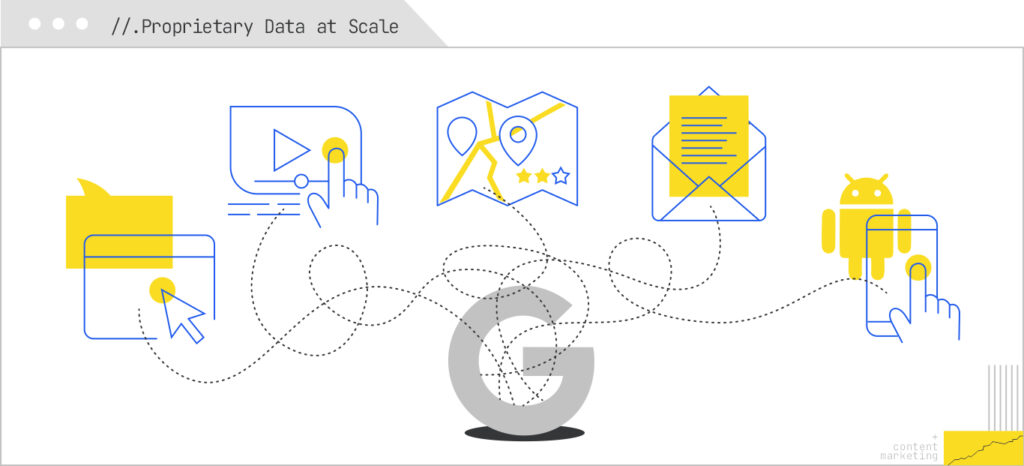
But what’s changing now is how Google uses this data to personalize the experience itself. In AI Mode, generative results are shaped by personal context, including past searches, app usage across Google properties, location and device behavior, and preferences taken from watch, read, and click histories.
This means Gemini isn’t just returning the most relevant content but also generating summaries that match the user’s individual patterns, priorities, and intent.
All of the above gives Google a real-time dataset that other companies simply don’t have. In fact, Google has more search query data than anyone. During the Department of Justice antitrust trial against Google, the DOJ said it would take 17 years for Bing to acquire 13 months of Google’s data.
Their proprietary data creates a feedback loop that helps Google:
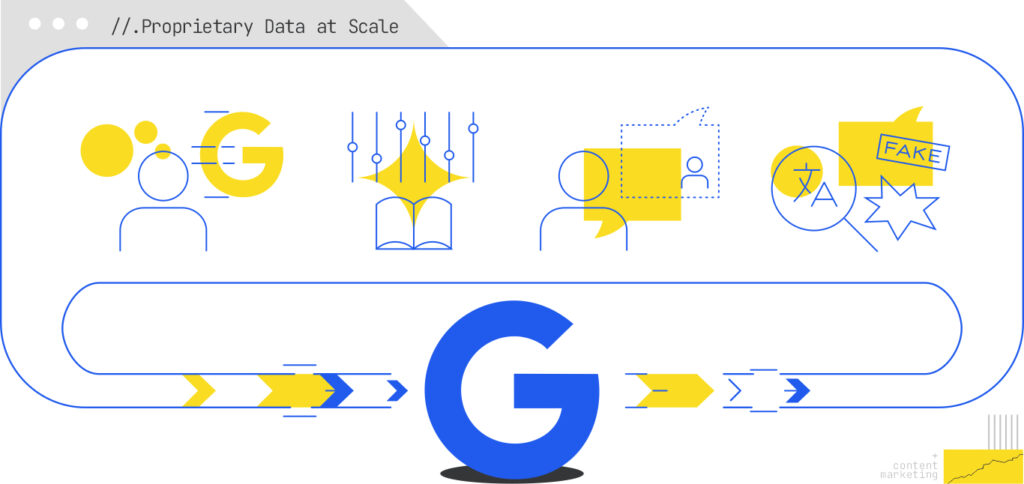
In short, Google’s models learn from what people are actually doing and searching for every day.
For brands and content creators, this has major implications. Google’s AI is cross-referencing your site with how users interact across its products. Content that aligns with real user behavior and intent signals is more likely to be recognized as useful.
This integrated dataset gives Google a long-term edge in how fast its AI can adapt and improve. Data scale equals model power these days, and Google’s scale is unmatched at the moment.
While many AI companies rely on third-party chips like NVIDIA (which is suffering from a chip shortage), Google has built its own Tensor Processing Units (TPUs).
TPUs are custom-designed chips built by Google to accelerate the kind of math operations that deep learning depends on.
They offer major advantages over general-purpose processors:
This means Google can train larger models more frequently and deliver answers faster and more affordably than competitors tied to commodity chips.
This advantage shows up in real ways across Google:
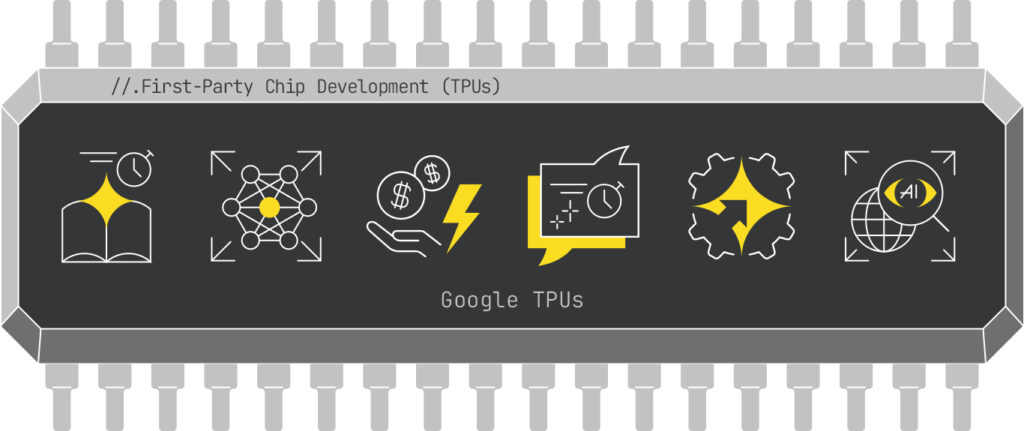
Because the hardware is built in-house, Google can align it tightly with its software and model needs, which is something competitors using third-party infrastructure can’t easily replicate.
For brands and content creators, this chip advantage shapes the speed and reach of AI search. Faster inference means more queries get AI-generated answers, scalable infrastructure means wider rollout of AI features like AI Mode and Overviews, and lower costs mean Google can experiment and deploy updates at a pace others may struggle to match.
Google owns multiple products with over a billion active users, giving it an instant audience to test, deploy, and refine AI features at unmatched speed.
Google’s billion-user platforms include:
These tools are the daily habits for billions of people, generating massive amounts of interaction data and behavioral feedback.
Having this built-in user base gives Google advantages:
This scale reshapes how discovery works:
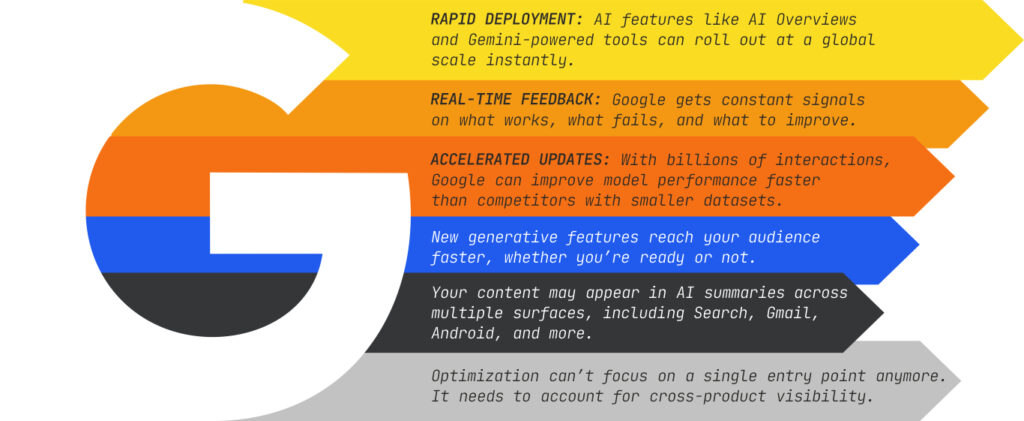
Google’s product scale acts like a distribution flywheel with more users meaning more data, better models, and more influence over how content is discovered.
Nearly every major large language model today is built on one core innovation: the Transformer architecture. And that breakthrough came from Google.
In 2017, researchers from Google Brain and Google DeepMind introduced the Transformer in their paper “Attention Is All You Need.” This architecture replaced older, slower models like Recurrent Neural Networks (RNNs) and Long Short-Term Memory networks (LSTMs) with something that could:
The Transformer became the blueprint for the entire generative AI industry. And because Google invented the foundational architecture, it holds a unique position in the AI ecosystem:
This advantage lets Google move from theory to product faster, whether it’s building Gemini, refining AI Overviews, or scaling new generative tools across its ecosystem.
For content creators and brands, this means the generative discovery engine you’re optimizing for is built by the original architects of the system itself. Google knows exactly how to fine-tune these models for search and user intent; it can update its models with greater precision and confidence, and its systems may favor content patterns aligned with its internal research direction.
Despite a rocky rollout and early controversies from incorrect information, Google’s AI Overviews have quickly become the most widely used generative AI product in the world. But this is mainly because it shows up unprompted in search results. Over 50 percent of search queries now show an AI Overview result, whether the user wants it or not.
As of 2024, AI Overviews have been rolled out to over 1.5 billion users globally, making them:
This puts Google far ahead of other generative interfaces in terms of daily engagement and visibility.
This level of adoption creates a powerful data feedback loop:
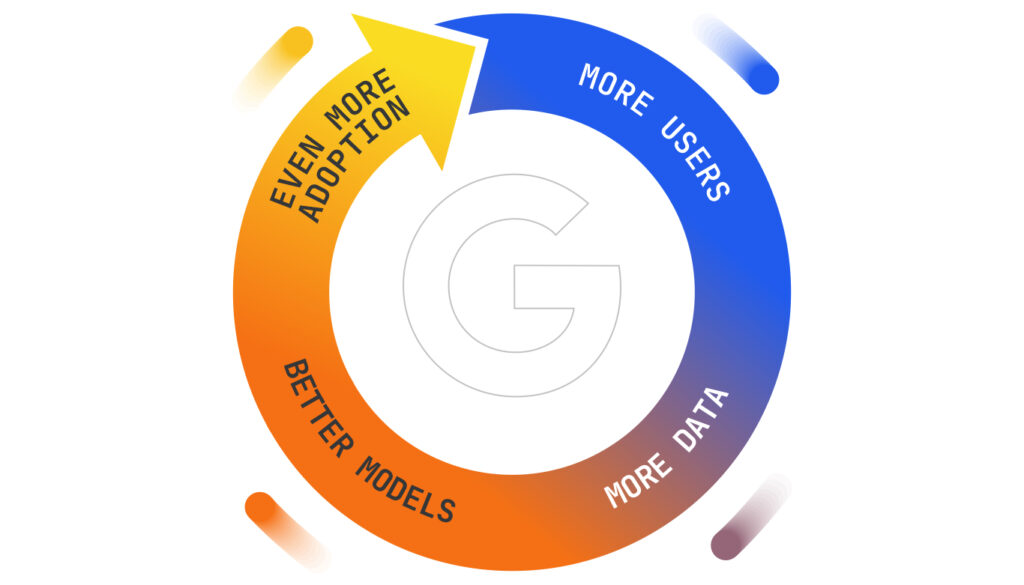
The result is a self-reinforcing cycle of more users → more data → better models → even more adoption.
For brands and content creators, AI Overviews are the mandatory front door of Google Search for a massive portion of audiences. Clicks are harder to come by this way, as the summary tends to keep people on the SERP, but presence in the answer matters more than ever.
If your brand isn’t being retrieved, synthesized, and cited in AI Overviews, AI Mode, ChatGPT, or Perplexity, you’re missing from the decisions that matter. Relevance Engineering structures content for clarity, optimizes for retrieval, and measures real impact. Content Resonance turns that visibility into lasting connection.
Schedule a call with iPullRank to own the conversations that drive your market.

The appendix includes everything you need to operationalize the ideas in this manual, downloadable tools, reporting templates, and prompt recipes for GEO testing. You’ll also find a glossary that breaks down technical terms and concepts to keep your team aligned. Use this section as your implementation hub.
//.eBook

The AI Search Manual is your operating manual for being seen in the next iteration of Organic Search where answers are generated, not linked.
Prefer to read in chunks? We’ll send the AI Search Manual as an email series—complete with extra commentary, fresh examples, and early access to new tools. Stay sharp and stay ahead, one email at a time.
Sign up for the Rank Report — the weekly iPullRank newsletter. We unpack industry news, updates, and best practices in the world of SEO, content, and generative AI.
iPullRank is a pioneering content marketing and enterprise SEO agency leading the way in Relevance Engineering, Audience-Focused SEO, and Content Strategy. People-first in our approach, we’ve delivered $4B+ in organic search results for our clients.
We’ll break it up and send it straight to your inbox along with all of the great insights, real-world examples, and early access to new tools we’re testing. It’s the easiest way to keep up without blocking off your whole afternoon.
